By Tom Darling, Conversations with Classic Boats
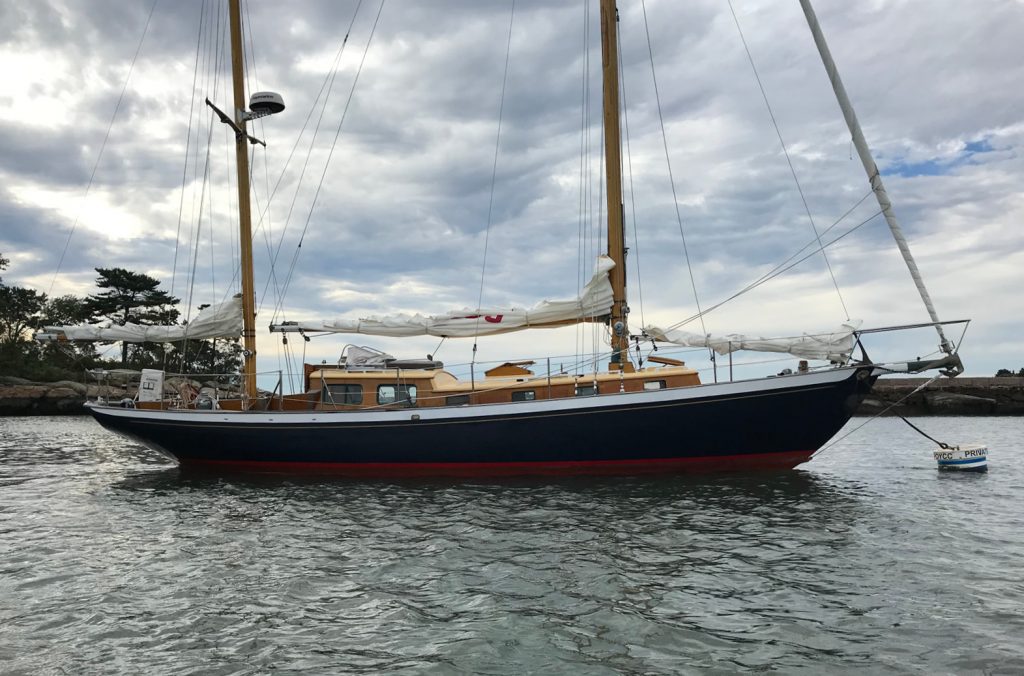
Abigail, 39 feet of Alden ketch, at anchor
In a typical Bermuda Race year, there is a small contingent of vintage boats, 50 years or older, who prepare for and participate in American offshore sailing’s Big Race. Many skippers opt for the Marion to Bermuda event, but Newport Bermuda is THE Bermuda Race.
Back in 2020 it was Jesse Terry’s intention to do the Big One. He had worked on his boat, counted the screws in her 65-year-old wooden hull, and recruited from his crew base of old friends from high school and college. Jesse was ready to go. As it was for so many yachtspeople, pandemic struck and forced a new timeline.
I had met Jesse shouting congratulations at him in 2018 for his winning of the Cruising Division in the Opera House Cup, Nantucket’s largest classic yacht event. He came back in 2020 for a repeat in a nasty nor’easter that saw a Nantucket Alerion sailed by my neighbor take the Cup. Now two years later, I was talking to Jesse about Bermuda 2022.
Two published versions of Jesse Terry’s quest to do Bermuda inspired our conversation. One was in late April in Scuttlebutt and the other Jesse’s posting on the Classic Yacht Owners Association’s website.
The story of Jesse and his boat, Abigail, goes back 65 years. You never ask classic boat sailors about their own background unless they volunteer. Only ask about the boat is the rule. Jesse Terry and Abigail are no exception. Back in August 2018 we were asking, “Who is that masked boat?” about the 39-foot Alden ketch that beat us in the OHC. The pictures that I studied ad nauseum on the Opera House Cup website showed a 12-ton boat, striking blue, a rare small Alden ketch, with the lines of a boat that I recognized, Carleton Mitchell’s Carib. The homeport was Noank. I called my friends in Noank. Who is Jesse Terry and what is Abigail?
The history of Abigail crossed paths with one of my favorite boat tales thus far, Finisterre and Fidelio, the S&S Twins, two of our fall podcasts in 2020.
Here’s geneology of the Twins and Abigail:
• Finisterre, born 1954 to Carleton Mitchell, his third child
• Abigail, born 1956 with the same builder, Seth Perrson, in Old Saybrook
• Finisterre, Olin Stephens’ tradition-busting ocean racer
• Abigail, John Alden’s design for offshore cruising, a modern take on one of his Malabars, one of the iconic American design models, the fishing schooner
• Finisterre, three successive overall wins in the Bermuda Race
• Abigail, winner of the Cruising Division, Opera House Cup, 2018 among others
The fact that Abigail has a hull almost identical to Carleton Mitchell’s first boat, Carib (formerly Malabar XII) seemed like more than a series of coincidences. She and Finisterre are a pair of two-masted classics from two of the premier naval architects in America. Here is what Jesse said in Scuttlebutt in April, 2022:
“I believe my work to prepare Abigail for this year’s Newport Bermuda Race is a tribute to John Alden, a founding father of offshore racing. Alden won the Bermuda Race three times on one of the Malabars.”
Jesse, who practices real estate in real life, has had a taste for classics since college. His boat preceding Abigail was an Augie Nielsen yawl, similar to the meticulously restored Annie of my Nantucket friend and Opera House Chairman Phil Smith. Jesse recited the provenance of the Abigail design:
“Although she is a ketch, her hull is derived from the fishing schooner and her heritage is from offshore cruising. Alden last won the Bermuda Race in 1932 in a race that included Olin Stephens on Dorade. It seems like 90 years later is a good time to try again.”
“How long does it take to get my 65-year old John Alden wood ketch ready to meet the requirements of one of the premier offshore racing events? Years. My journey started seven years ago by preparing the boat for offshore cruising. Over the first winter, three men replaced 4,000 screws fastening the hull together. Then it was a focus on the rigging, both standing and running. By the spring, we had new sails that optimized the two-masted rig. We tested all that stuff sailing back and forth from Southern New England to Maine and Nova Scotia.”
“The next winter, many more hours were spent working on the teak decks and replacing through-hulls and plumbing. We then added some modern gear like electronics, new winches and better blocks. We tested the new gear by participating in classic yacht races up and down the New England Coast.”
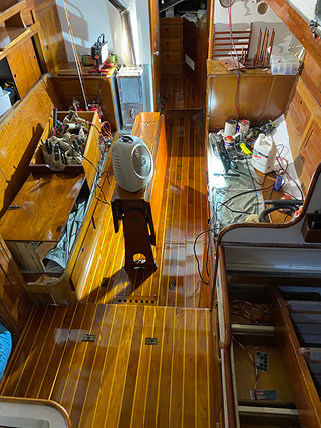
A lot goes into redoing a classic ocean cruiser.
“When COVID hit, there seemed to be more winter hours available. I looked at the Marion Bermuda inspection list with my crew and we thought there was a chance. I’d sailed on a wood S&S yawl in the Newport Bermuda Race four times prior. It was an incredible journey every time, including winning our class in 2012 and making the program cover in 2014.” That boat was Black Watch, the 68-foot S&S yawl built to win the Bermuda Race for its owners, the Schaeffer family.
Abigail was actually built for offshore cruising, but only two years after Finisterre. Two different shapes, two different philosophies. Alden, the American vernacular designer, taking his cues from the lines of traditional fishing schooners: plenty of sheer, deep keels. Think back to our podcast “Finisterre and Fidelio, the S&S Twins” in late 2020. Fidelio owner Chuck Townsend described the design as pumpkin shaped, buoyant for the worst sea conditions and – Gasp! – with a large centerboard to tune and balance the boat over a wide variety of conditions.
Jesse has researched the history of Alden, a prolific creator of New England designs from the Town class and frostbite dinghies to large and elegant oceangoing schooners. The MIT Museum holds Alden’s legacy of plans and drawings, side by side with the Herreshoff Collection. But to race a cruising design to Bermuda meant bringing Abigail up to 2022 code.
“The to do list for a 600-mile plus ocean race is not what it was in the 1950s,” said Jesse. “The safety gear requirements are eye-opening, but I was at least ahead of the supply chain issues and wave of new boaters in the market. Then there was the minutiae, like securing floorboards and drawers or installing gaskets in lazarettes or a harness point in the companionway. It was a pretty long list that took more time than expected. Springtime arrived and COVID took out the 2020 Race.”
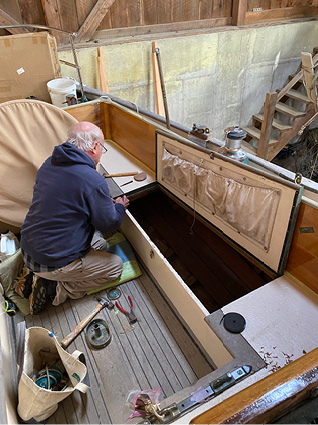
Installing the safety features required for the Bermuda
With another winter and a new year to prepare for sailing to Bermuda, Jesse continued, “I looked at the Newport Bermuda inspection list and was surprised there was even more to do. I then took advantage of every helping hand of the race organizers including a ‘pre-inspection’ and the assignment of a mentor through their Race Ambassador program. Now, I think I am on schedule.”
Meanwhile, my good friend and IOD Etisian syndicate owner Elliot Merrill is taking a radically different approach to racing to Bermuda. He is attacking the Gulf Stream with a brand new Lyman Morse-built custom 46. That green LM 46 came into Stonington Harbor in early May, after a fast passage from her Maine birthplace. Elliot, a longtime veteran of the Bermuda Race, mostly with his vintage J/42, is going with a boat splashed 65 years after Abigail.
Jesse and Elliot find themselves in the St. David’s Lighthouse Division with 113 other entries. That elite group had seven divisions of its own in 2018 and in 2022, the SDLD represents more than half the size of the fleet that numbered 203 entrants in mid-May. Overall, it is so far the second largest set of entrants for a race that started in 1906.
According to Bob MacKay, who has written a fascinating book called The Golden Age of Newport Yachting: Between the Wars, there is one authority on the Bermuda Race that he swears by. John Rousmaniere, author of A Berth to Bermuda, could very well be the living, breathing authority on the biennial race.
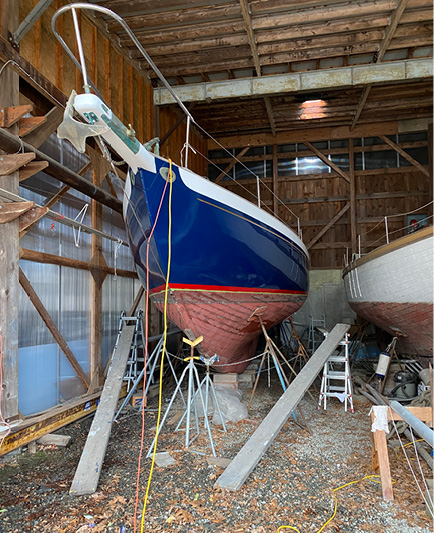
In the shed getting a makeover
An excerpt from his work, found online as a series of stories, describes the very first Bermuda Race as “an act of rebellion. In 1906, the Establishment believed that it would be insane for amateur sailors to race offshore in boats under 80 feet. Thomas Fleming Day, the feisty editor of the Rudder, vehemently disagreed, insisting ‘the danger of the sea for generations has been preached by the ignorant.’ Certain that an ocean race would be enjoyable and safe – and also develop better sailors and better boats – Day founded one on his own. The Brooklyn Yacht Club started the race in New York Bay and down on the island paradise, the Royal Bermuda Yacht Club finished it off St. David’s Head.”
The smallest entry then (and in Bermuda Race history) was the 28-foot sloop Gauntlet. She was notorious for her size and also for her crew because it included a woman, 20-year-old Thora Lund Robinson. Today, upwards of 300 women are competing in a Bermuda Race.
Rousmaniere continued, “The winner that year was the 38-foot yawl Tamerlane, with Thomas Fleming Day himself as sailing master. When he reached the Royal Bermuda Yacht Club quay under tow, 4,000 of the island’s 14,000 residents were there to greet her. There were four more races before the sailors decided it was too much to ask that the race be held annually.”
To summarize Rousmaniere’s historical account, the 1923 race starting from New London was a grueling one but all 22 boats finished. In 1926, the Cruising Club of America and the RBYC teamed up to host the race. To date, only two boats have been lost, one on a Bermuda reef and another in a fire in 1932 that resulted in the race’s only loss of life.
Nothing seems to phase Jesse Terry. “It only took seven years, but now I can focus on a launch date and the developing patterns of the Gulf Stream.” He went on to observe that there are nine other CYOA classic yachts in this year’s race. Hopefully all can tune up together in early June’s NYYC Annual Regatta, racing for the Tiedemann Trophy, named after the late classicist Bob Tiedemann, a familiar figure with his Clinton Crane-designed 12 Metre Gleam. June 17 marks the day of this year’s 635-mile Thrash to the Onion Patch.
That Friday , two weeks after this article appears, all that effort, the starts and stops, the screws replaced, the lists ticked off, will be in the past and the thrash southeast, jousting with the Gulf Stream, in search of a single limestone island, will be underway. Good luck Jesse, and good luck Elliot. May the best boat win! We’ll be watching at the start. ■
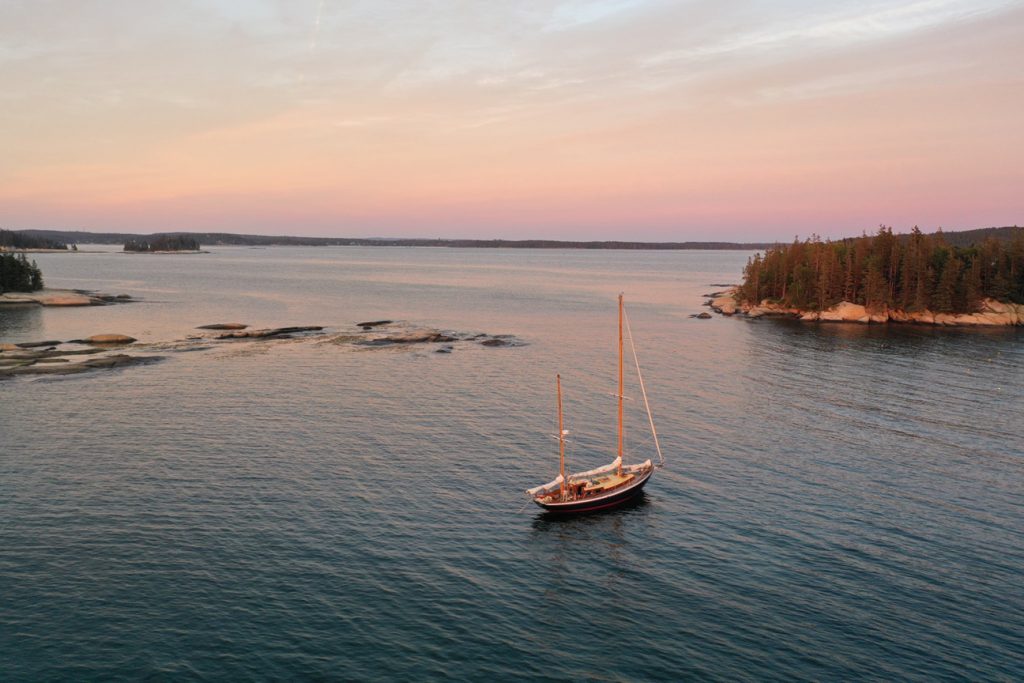
A quiet anchorage, somewhere in Maine
Thanks to Craig Leweck of Scuttlebutt for allowing the use of his feature on Jesse and Abigail. The same goes for the Classic Yacht Owners Association which posted the same story on their website.
Tom Darling is the host of Conversations with Classic Boats, “the podcast that talks to boats.” Tune in via Apple Podcast, Google Podcast or Spotify, or online at conversationswithclassicboats.com.
Corrections to our May article, “Story Boats: The Tales They Tell”
When the deadline for our May issue came on April Fool’s Day, Mystic Seaport Museum’s exhibit featuring eighteen iconic watercraft displayed in the Collins Gallery of the Thompson Exhibition Building was under construction. Mary Anne Stets, the Museum’s Director Business Development & Intellectual Property, subsequently noted some corrections, which can be found at
windcheckmagazine.com/article/story-boats-the-tales-they-tell/
